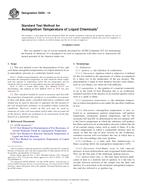Potrebujeme váš súhlas na využitie jednotlivých dát, aby sa vám okrem iného mohli ukazovať informácie týkajúce sa vašich záujmov. Súhlas udelíte kliknutím na tlačidlo „OK“.
ASTM E659-14
Standard Test Method for Autoignition Temperature of Liquid Chemicals
Automaticky preložený názov:
Štandardná skúšobná metóda pre Samovznietenie kvapalných chemikálií
NORMA vydaná dňa 1.2.2014
Informácie o norme:
Označenie normy: ASTM E659-14
Poznámka: NEPLATNÁ
Dátum vydania normy: 1.2.2014
Kód tovaru: NS-47550
Počet strán: 7
Približná hmotnosť: 21 g (0.05 libier)
Krajina: Americká technická norma
Kategória: Technické normy ASTM
Anotácia textu normy ASTM E659-14 :
Keywords:
ICS Number Code 71.080.01 (Organic chemicals in general)
Doplňujúce informácie
| Significance and Use | ||||||
|
5.1 Autoignition, by its very nature, is dependent on the chemical and physical properties of the material and the method and apparatus employed for its determination. The autoignition temperature by a given method does not necessarily represent the minimum temperature at which a given material will self-ignite in air. The volume of the vessel used is particularly important since lower autoignition temperatures will be achieved in larger vessels. (See Appendix X2.) Vessel material can also be an important factor. 5.2 The temperatures determined by this test method are those at which air oxidation leads to ignition. These temperatures can be expected to vary with the test pressure and oxygen concentration. 5.3 This test method is not designed for evaluating materials which are capable of exothermic decomposition. For such materials, ignition is dependent upon the thermal and kinetic properties of the decomposition, the mass of the sample, and the heat transfer characteristics of the system. 5.4 This test method can be employed for solid chemicals which melt and vaporize or which readily sublime at the test temperature. No condensed phase, liquid or solid, should be present when ignition occurs. 5.5 This test method is not designed to measure the autoignition temperature of materials which are solids or liquids at the test temperature (for example, wood, paper, cotton, plastics, and high-boiling point chemicals). Such materials will thermally degrade in the flask and the accumulated degradation products may ignite. 5.6 This test method can be used, with appropriate modifications, for chemicals that are gaseous at atmospheric temperature and pressure. 5.7 This test method was developed primarily for liquid chemicals but has been employed to test readily vaporized solids. Responsibility for extension of this test method to solids of unknown thermal stability, boiling point, or degradation characteristics rests with the operator. |
||||||
| 1. Scope | ||||||
|
1.1 This test method covers the determination of hot- and cool-flame autoignition temperatures of a liquid chemical in air at atmospheric pressure in a uniformly heated vessel. 1.2 This standard should be used
to measure and describe the properties of materials, products, or
assemblies in response to heat and flame under controlled
laboratory conditions and should not be used to describe or
appraise the fire hazard or fire risk of materials, products, or
assemblies under actual fire conditions. However, results of this
test may be used as elements of a fire risk assessment which takes
into account all of the factors which are pertinent to an
assessment of the fire hazard of a particular end use.
|
||||||
| 2. Referenced Documents | ||||||
|
Odporúčame:
Aktualizácia technických noriem
Chcete mať istotu, že používate len platné technické normy?
Ponúkame Vám riešenie, ktoré Vám zaistí mesačný prehľad o aktuálnosti noriem, ktoré používate.
Chcete vedieť viac informácií ? Pozrite sa na túto stránku.




 Cookies
Cookies
